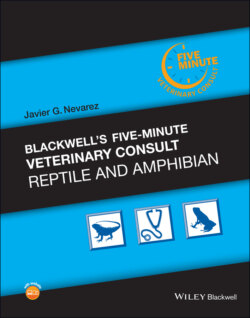Читать книгу Blackwell's Five-Minute Veterinary Consult: Reptile and Amphibian - Javier G. Nevarez - Страница 171
Оглавление
Exophthalmia
BASICS
DEFINITION/OVERVIEW
Exophthalmia is the anterior protrusion of a normal‐sized globe.
ETIOLOGY/PATHOPHYSIOLOGY
Space‐occupying swelling or mass in the orbit placing pressure on the globe, displacing it anteriorly.
SIGNALMENT/HISTORY
There is no standard signalment for this disease.
Gradual protrusion of the eye, possibly preventing blinking, and potentially anorexia are common findings in the history.
CLINICAL PRESENTATION
While it can be bilateral, exophthalmia is more commonly unilateral.
The displacement of the globe will often push the eyelids forward and cause protrusion of the nictitans, and excessive conjunctiva will be visible.
Retropulsion of the globe is met with resistance due to the presence of retrobulbar swelling.
RISK FACTORS
Husbandry
Inadequate husbandry, especially hypothermia, may predispose animals to this condition due to decreased immune function leading to retrobulbar cellulitis and/or abscessation.
Hypovitaminosis A in chelonians causes squamous metaplasia of the orbital glands and ducts, as well as decreased immune function, and may present as bilateral exophthalmia.
Others
N/A
DIAGNOSIS
DIFFERENTIAL DIAGNOSIS
It is important to first differentiate between exophthalmia and buphthalmos.
The most common cause for exophthalmia in chelonians is retrobulbar abscessation.
Other differentials include cellulitis, trauma, granulomas, neoplasia, mucoceles, and sialadenitis.
In tortoises, vascular obstruction and generalized edema have been reported to cause bilateral exophthalmia as well.
DIAGNOSTICS
Physical examination will confirm exophthalmia, but additional diagnostics are necessary to determine the cause.
Ocular ultrasound is helpful in evaluating the problem, although the scleral ossicles can limit visualization.
Advanced imaging, such as CT or MRI, is most helpful in determining the extent of the mass and if resection is possible.
Surgical exploratory of the retrobulbar space to collect biopsies and resect any masses present in the most definitive way to achieve a diagnosis but in many cases requires enucleation to reach the retrobulbar space.
A CBC may provide information on the severity of the infection/inflammation.
PATHOLOGICAL FINDINGS
Histology and culture are most useful to diagnose the cause of the exophthalmia and allow the clinician to form an appropriate treatment plan.
TREATMENT
APPROPRIATE HEALTH CARE
N/A
NUTRITIONAL SUPPORT
Additional nutritional support is not necessary if the animal is eating, but it may be necessary to tube feed or place an esophagostomy tube if the animal is anorexic.
Assessment of the diet for adequate vitamin A levels is important and should be done to rule out hypovitaminosis A as a potential cause or contributor to this condition in chelonians.
CLIENT EDUCATION/HUSBANDRY RECOMMENDATIONS
While exophthalmia can occur in any animal, those with husbandry deficiencies may be at increased risk.
In addition to medical and surgical therapy, maximizing the husbandry of the animal will improve the chances of a successful outcome.
MEDICATIONS
DRUG(S) OF CHOICE
Treatment should be based on results of culture, histology, and/or FNA.
Starting an appropriate broad‐spectrum antibiotic with a good Gram‐negative spectrum (e.g., ceftazadime 20 mg/kg IM or SQ q48–72h) and anti‐inflammatory (e.g., meloxicam 0.2–0.3 mg/kg IM or SQ q24–48h) can be helpful while test results are pending.
PRECAUTIONS/INTERACTIONS
N/A
FOLLOW‐UP
PATIENT MONITORING
Serial CBC, especially if the first one was abnormal, may provide an indication of response to treatment.
EXPECTED COURSE AND PROGNOSIS
Prognosis is related to the underlying cause of the exophthalmia.
Cellulitis and trauma have the most favorable outcomes.
Retrobulbar abscesses can be extensive and therefore carry a more guarded prognosis.
Retrobulbar neoplasia usually carries a poor prognosis because of location and inability to get clean margins.
MISCELLANEOUS
COMMENTS
N/A
ZOONOTIC POTENTIAL
Depends on the cause of the retrobulbar swelling but generally low to no zoonotic potential.
SYNONYMS
Exophthalmos
Proptosis—severe case of exophthalmia
ABBREVIATIONS
CBC = complete blood count
CT = computed tomography
FNA = fine‐needle aspiration
MRI = magnetic resonance imaging
Suggested Reading
1 Boyer TH. Turtles, Tortoises, and Terrapins. In: Mader DR, ed. Reptile Medicine and Surgery. 2nd ed. St. Louis, MO: Elsevier Saunders; 2006:696–704.
2 Hochleithner C, Holland M. Ultrasonography. In: Mader, DR, Divers SJ, eds. Current Therapy in Reptile Medicine and Surgery. Saint Louis, MO: Elsevier Saunders; 2014:107–127.
3 Lawton MPC. Reptilian Ophthalmology. In: Mader DR, ed. Reptile Medicine and Surgery. 2nd ed. St. Louis, MO: Elsevier Saunders; 2006:323–342.
Author Christopher S. Hanley, DVM, DECZM
